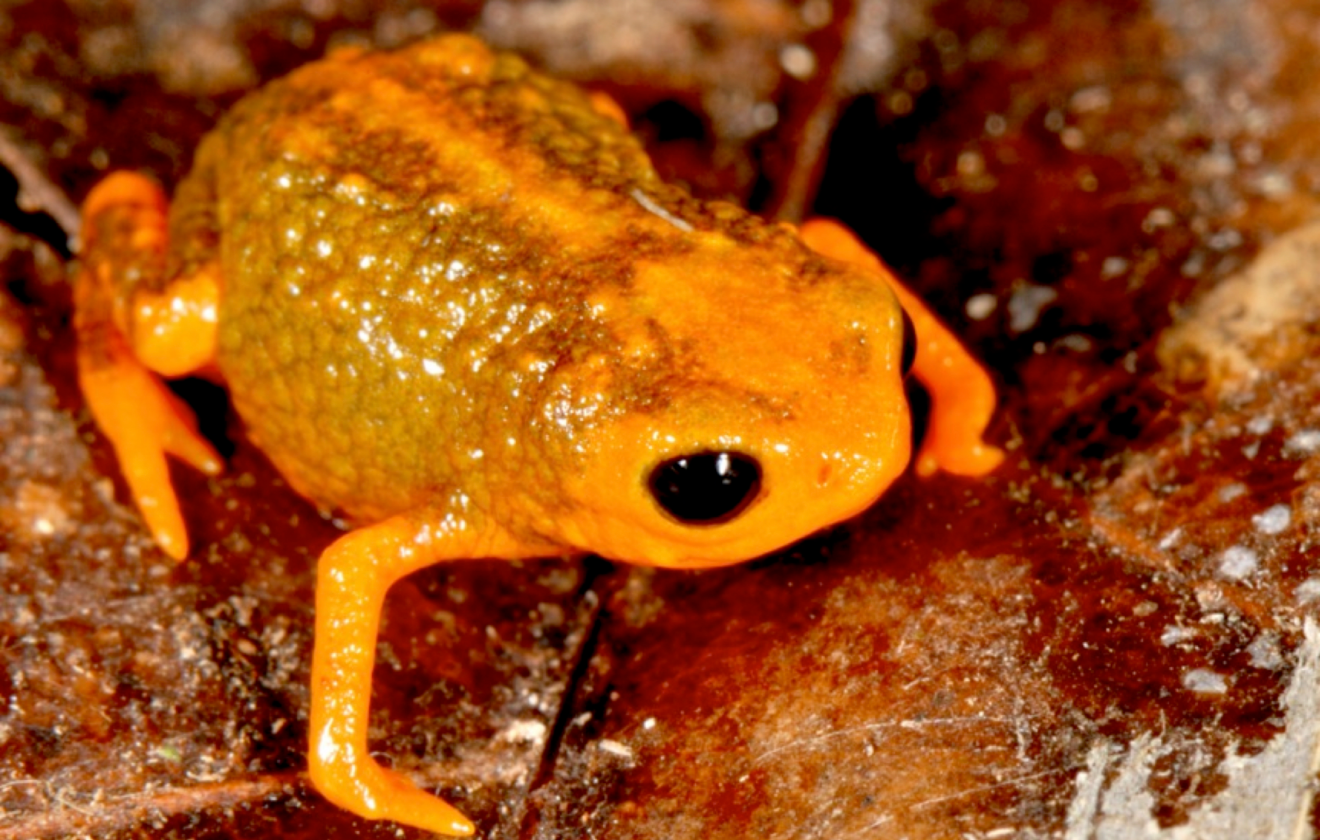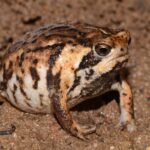- Brachycephalus boticario: The Hidden Jewel of Brazil’s Atlantic Forest
- Taxonomy and Classification of Brachycephalus boticario
- A Home Among Rich Green Leaves: Habitat and Distribution
- Physical Characteristics: A World in Miniature
- The Remarkable Lives and Behaviors of Brachycephalus boticario
- Ecological Roles: Tiny Actors on a Grand Stage
- Threats and Conservation Status
- Cultural and Scientific Significance
- Conclusion: Preserving the Beauty and Mystery
Brachycephalus boticario: The Hidden Jewel of Brazil’s Atlantic Forest#
Deep within the verdant embrace of Brazil’s Atlantic Forest, a world unfolds where the air is thick with humidity, the shadows rich with mystery, and each leaf might veil some secret miracle of evolution. Among these miracles thrives a remarkable amphibian known for its diminutive size, vibrant colors, and an intriguing blend of adaptations—the Brachycephalus boticario, a species so exquisite and elusive, it holds fascination even among the most seasoned naturalists.
Named in tribute to the Brazilian Fundação Grupo Boticário, instrumental in supporting biodiversity conservation, this tiny frog embodies the treasure trove of biological diversity nestled within one of Earth’s richest yet most threatened ecosystems. At first glance it is wondrous enough to contemplate life on such miniature scales, yet beyond its charm lies insight into specialized survival strategies in habitats which teeter on the brink of vulnerability.
Taxonomy and Classification of Brachycephalus boticario#
To fully appreciate the importance of this compelling amphibian, we must journey into the realm of scientific taxonomy where hidden stories of evolutionary kinship unfold. Classified under the family Brachycephalidae, this species belongs to the genus Brachycephalus, celebrated for its amazingly small frogs that are often less than two centimeters in length, and distinctive for their stunningly bright coloration—which usually signals toxic defenses.
Officially described in 2015 by Ribeiro et al., Brachycephalus boticario joined a lineage whose members share characteristics like reduced phalanges, limited fingers, and a robust, rounded body shape. Closely related species such as Brachycephalus pitanga and Brachycephalus leopardus similarly flaunt bold pigments and intriguing adaptations, illustrating a beautiful but cautionary tale of localized differentiation and vulnerability inherent in isolated pockets of habitat.
A Home Among Rich Green Leaves: Habitat and Distribution#
The Atlantic Forest, or Mata Atlântica, is a mosaic of astonishing biodiversity spanning the Brazilian coastline. It once blanketed vast areas from north to south, yet now exists as fragments threading through human-altered landscapes. Within this complex ecological tapestry, Brachycephalus boticario claims a small, distinct territory.
Geographic Range#
Found exclusively in the montane rainforests of the southern Brazilian state of Paraná, primarily within regions of the Serra da Baitaca and surrounding highlands, this species occupies elevations typically ranging from 850 to 1,800 meters above sea level. Here, the frog thrives in dense foliage and leaf litter, beneath canopies shimmering green with perpetual moisture.
Specific Habitat Preferences#
Imagine stepping onto soft beds of moss and leaves, moisture dripping gently from leaves high above—a gentle soundscape filling the air with hums and chirps. Beneath your feet, concealed by shadows and well-camouflaged amongst vibrantly colored vegetative detritus hides the minute Brachycephalus boticario. Preferring leaf litter and moist microhabitats, these frogs are masters of microhabitat specialization. Each fallen leaf, each shallow crevice becomes its world—a domain rich in microscopic interactions forming the foundation for their survival.
Physical Characteristics: A World in Miniature#
The very essence of wonder surrounds the appearance of Brachycephalus boticario. Only 13-14 millimeters in adult length, this tiny ambassador of biodiversity nonetheless captivates with vivid hues that range from bright, fiery orange to hues of pumpkin and gold. Its small body is robust, slightly rounded, with shortened, sturdy limbs adapted to navigating the complex leaf litter rather than lengthy leaps.
One of the most intriguing aspects of its coloration is that intense pigmentation typically corresponds to aposematic signaling, a clear warning to would-be predators of potential toxic or distasteful properties. Indeed, these frogs are known for possessing alkaloid toxins in their skins, derived largely from their diet—an adaptation that enhances their defense, allowing them to journey through their miniature habitat with fewer threats.
The Remarkable Lives and Behaviors of Brachycephalus boticario#
Mysteries of Feeding and Diet#
Life amid the moist decadence of fallen Atlantic Forest leaves provides ample feeding opportunities for such minute amphibians. Primarily insectivorous, Brachycephalus boticario snacks skillfully on tiny arthropods, including mites, ants, small beetles, and springtails. Equipped with keen visual acuity for prey detection and strategically slow, deliberate movements, they efficiently navigate a miniature jungle of leaf veins, twigs, and soil.
Mating Rituals and Breeding Habits#
During the rainy season, coated in droplets of fine mist typical of montane habitats, males begin their delicate chorus—an ensemble of high-pitched vocalizations vibrating softly from hidden positions beneath moist leaves. These distant choruses, audible only to attentive ears, beckon receptive females. Their breeding strategy reveals another remarkable adaptation: terrestrial egg deposition. Unlike conventional frogs, they forego aquatic larval stages entirely. Females lay small batches of eggs within humid leaf litter, allowing embryos to directly develop into tiny, perfectly formed froglets.
Ecological Roles: Tiny Actors on a Grand Stage#
Despite its modest stature, Brachycephalus boticario plays a significant ecological role within its microhabitat. Controlling populations of minute arthropods, these frogs help maintain ecological balance within leaf litter ecosystems. Conversely, amphibians like these also support local predator populations—spiders, small snakes, and birds—despite their protective alkaloids. Furthermore, their sensitivity to environmental changes highlights their significance as bioindicators, offering valuable insights into ecosystem health.
Threats and Conservation Status#
Though relatively recent discoveries leave exact population trends elusive, habitat degradation and fragmentation pose imminent threats to the longevity of this species. Expanding agriculture, urbanization, and logging have fractured the once-continuous stretches of Atlantic rainforest habitat into isolated segments, challenging continued viability and gene flow between populations. Additionally, climate change, bringing shifts to rainfall patterns and humidity, further intensifies pressure on these frog populations.
Currently classified as Data Deficient by the International Union for Conservation of Nature (IUCN), Brachycephalus boticario urgently requires focused research to establish targeted conservation actions and ensure its continued presence within these precious forest fragments. Promising initiatives include the Fundação Grupo Boticário’s ongoing support for protected areas and ecological corridors designed to secure long-term habitat connectivity and protection.
Cultural and Scientific Significance#
Beyond their ecological significance, the discovery and naming of Brachycephalus boticario exemplify critical themes in modern conservation biology, highlighting partnerships between scientific institutions and private enterprises dedicated to environmental stewardship. Scientifically, each recently unearthed Brachycephalus species enriches understanding of evolution, speciation, and niche specialization—an important narrative underscoring why conservation efforts must protect not just charismatic megafauna but even the humblest, least visible inhabitants of ecosystems.
Conclusion: Preserving the Beauty and Mystery#
Each encounter with a species like Brachycephalus boticario reminds us that nature’s splendor lies not merely in grand vistas but profoundly in its smallest details. It illustrates with stunning clarity the deep interconnectedness between organisms and their environments, providing powerful lessons about adaptability, fragility, and the urgency of conservation.
By learning about, appreciating, and advocating for creatures like Brachycephalus boticario, we embrace our responsibility as stewards of the incredible biodiversity that we share this world with, ensuring these hidden jewels remain, forever vibrant and vital, amid the whispered greenery of Brazil’s Atlantic Forest.










